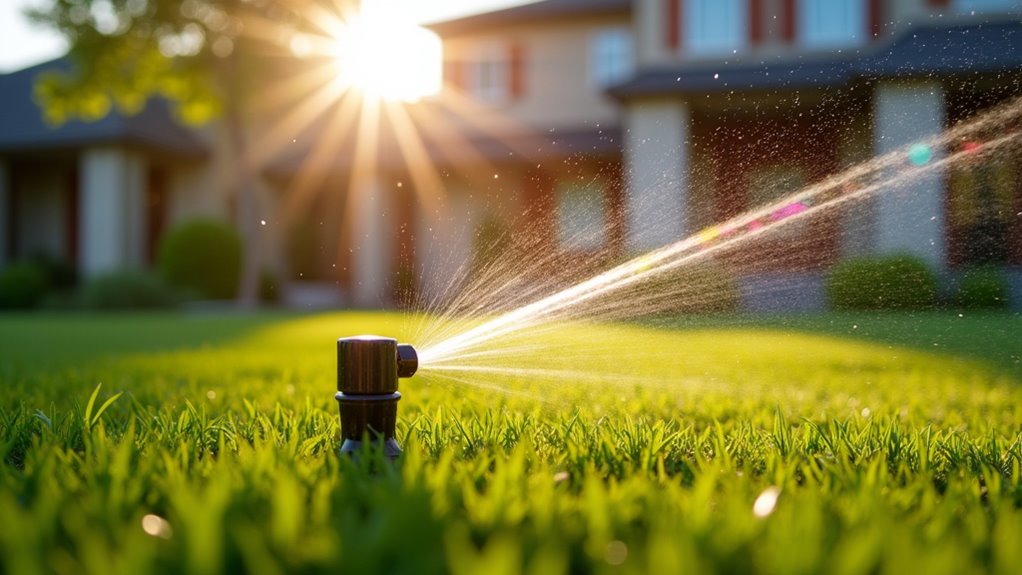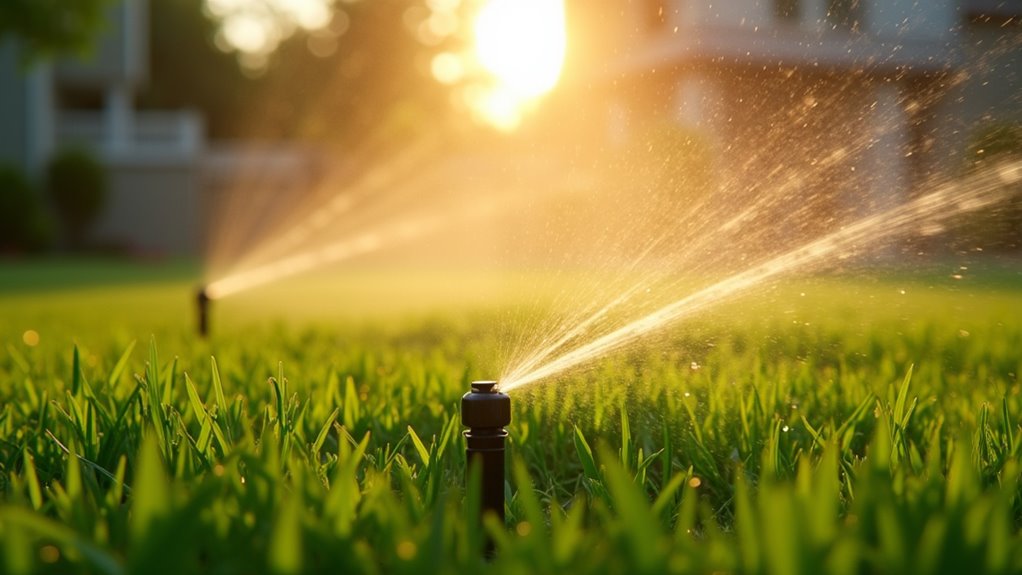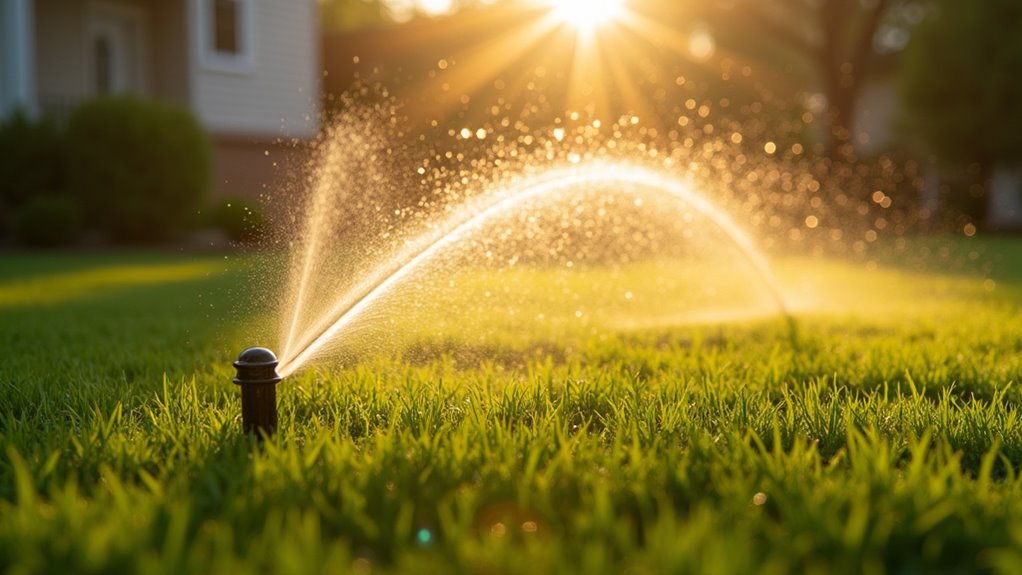Transform your lawn’s scenery by viewing it from across the street to gain fresh perspective. Start with strategic plant placement, positioning larger specimens as anchors while incorporating varied textures and colors through ornamental grasses and container gardens. You’ll want to maintain pristine exterior features with clean edges, weed-free beds, and well-preserved hardscaping elements. Create visual balance by blending architectural features with natural elements. Uncover how these foundational principles can enhance your outdoor space’s lasting appeal.
Evaluating Your Current Landscape Design
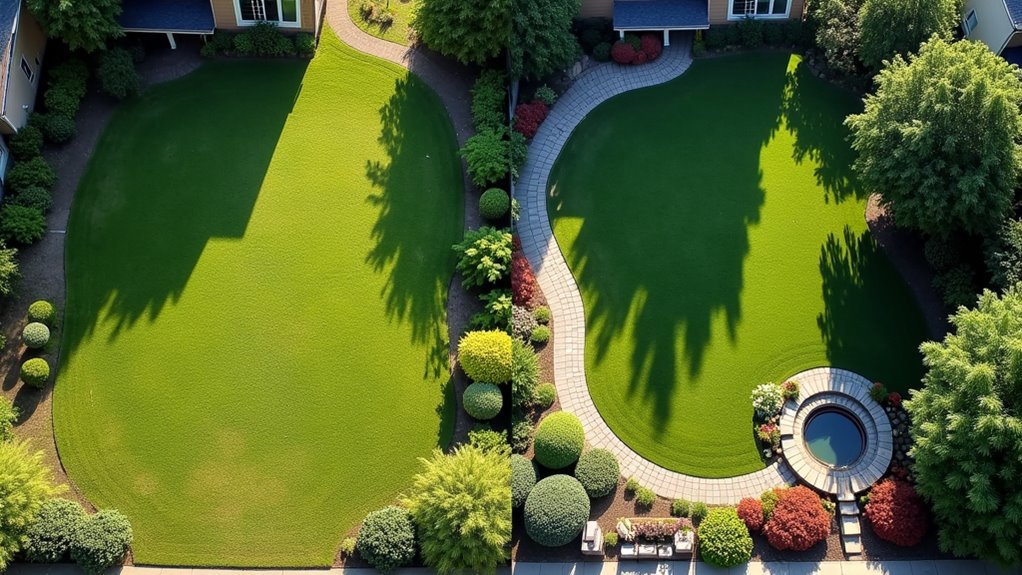
When was the last time you truly stepped back and assessed your terrain with fresh eyes? To gain a fresh perspective on your scenery’s curb appeal, position yourself across the street from your home’s front entrance. This vantage point helps you spot areas that need attention, from unsightly weeds to cracked pavement.
Look beyond just maintaining a green lawn – evaluate how your existing plants and hardscape elements work together to create a cohesive design. Consider whether your current landscape complements your home’s architectural style. Are there areas that could benefit from new plants or professional pressure washing to revitalize worn surfaces? Pay special attention to the overall equilibrium and flow of your front yard, ensuring that each element contributes to a polished, well-maintained appearance that makes a lasting impression.
Essential Elements of Curb Appeal
Strategic placement of plants around your home’s exterior creates visual interest while complementing your architectural style and highlighting key features. You’ll optimize curb appeal by maintaining pristine exterior elements, including a weed-free lawn, clean siding, and well-preserved paint or trim work. Incorporating a thoughtful balance of colors and textures through container gardens, ornamental grasses, and varied foliage will establish a dynamic, professional outdoor design that draws attention from the street.
Strategic Plant Placement
The art of plant placement transforms an ordinary yard into an alluring scenery that draws attention to your home’s best features. When designing your front yard landscaping, you’ll want to establish visual balance by positioning larger plant material as anchoring elements. Create structure with substantial shrubs, then layer in smaller plants for color and textural interest.
To maximize curb appeal, arrange your plants in cohesive groups or repeating patterns that complement your home’s architectural features. You’ll achieve the most impact by carefully considering each plant’s mature size and growth habits. Frame your entryway with symmetrical plantings that naturally guide visitors to your front door. Remember to position taller specimens where they’ll highlight architectural elements without overwhelming the space, ensuring your landscape design remains proportionate and visually striking.
Well-Maintained Exterior Features
Maintaining pristine exterior features serves as the foundation for exceptional curb appeal. You’ll maximize your home’s value by investing in meticulous lawn care, ensuring your grass remains weed-free and impeccably groomed. Thoughtful landscaping includes freshly mulched garden beds and precisely edged borders, creating clean lines that define your outdoor spaces.
Don’t overlook the transformative power of landscape lighting, which strategically illuminates your home’s architectural features while creating an inviting evening ambiance. Consider incorporating native plants and drought-tolerant plants to demonstrate sustainable design principles. To complete your property’s polished appearance, pressure wash exterior surfaces to remove accumulated dirt and restore their original luster. These well-maintained elements work together to create a cohesive, professional landscape that substantially enhances your home’s market appeal and aesthetic value.
Color and Texture Balance
Harmonious color and texture combinations form the cornerstone of an engaging scenery design. When you’re looking to enhance your home’s curb appeal, strategic placement of trees and shrubs alongside vibrant flowers creates a captivating first impression. Your landscape’s visual appeal depends on thoughtful layering and careful attention to seasonal changes.
- Mix plants with varying bloom cycles to maintain year-round color, incorporating early spring bulbs through late-fall perennials
- Position taller elements behind shorter plants to create depth, using trees and shrubs as your backdrop
- Echo specific colors and shapes throughout your design to establish a unified, professional appearance
- Select contrasting textures and forms that complement your home’s architecture while adding distinctive character to the overall landscape
Your design choices should reflect a balanced approach, combining bold statements with subtle shifts to achieve maximum impact.
Strategic Plant Selection and Placement
When planning your landscape design, you’ll want to incorporate drought-resistant plant groupings that include native species like ornamental grasses, succulents, and hardy perennials to guarantee sustainable beauty with minimal water requirements. Creating visual depth through height layering starts with positioning tall evergreens and flowering trees in the background, followed by medium-sized shrubs in the middle ground, and low-growing groundcovers in the foreground. Your plant selection strategy should balance both practical water conservation needs and aesthetic principles of layered design to achieve a cohesive, professional look that improves your home’s architecture.
Drought-Resistant Plant Groups
Strategic grouping of drought-resistant plants transforms your lawn into a water-wise sanctuary while maintaining visual appeal. By incorporating native plants and xeriscape garden principles, you’ll create distinct zones that minimize landscape maintenance while maximizing efficiency. Group your drought-resistant plants based on their specific needs to guarantee optimal growth and reduced water consumption.
- Position water-loving plants near your home’s foundation to take advantage of natural runoff
- Create clusters of drought-resistant natives like yucca, agave, and lantana in drier areas
- Combine cacti and succulents in full-sun locations where they’ll thrive together
- Layer 2-3 inches of mulch around each plant grouping to retain moisture
This thoughtful arrangement not only conserves water but also creates a cohesive design that celebrates the natural beauty of drought-resistant species.
Visual Height Layering
Creating depth and visual intrigue in your terrain begins with thoughtful height layering, where each plant’s natural stature contributes to a multi-dimensional design. Your home’s curb appeal relies heavily on strategic plant choices, from ground-hugging varieties to towering ornamental grasses.
Start with something as simple as positioning taller shrubs and perennials at the garden’s rear, then work forward with medium-height plants and low-growing groundcovers. Add vertical interest by incorporating decorative stone obelisks or trellises as architectural elements that draw the eye upward. By staggering plants with varied bloom times throughout these height zones, you’ll maintain visual interest across seasons. Remember to repeat similar plant groupings in a rhythmic pattern – this technique creates harmony while maintaining the depth you’ve achieved through careful height consideration.
Creating Visual Balance With Hardscaping

The art of balancing hardscaping elements within your lawn creates a foundation that ties your entire outdoor space together. A successful landscape design seamlessly blends structural features with natural elements, enhancing your home design while elevating property value. Your attractive landscape should incorporate hardscape elements thoughtfully, creating a simple landscape that’s both functional and visually appealing.
- Position walkways and paths to naturally guide visitors through your outdoor spaces while complementing existing architecture
- Install retaining walls strategically to add depth and create distinct zones within your landscape
- Select patio materials that echo your home’s exterior finishes for a cohesive appearance
- Balance hard surfaces with strategic plant placement to soften edges and create visual harmony
These design principles guarantee your hardscaping contributes to a polished, professional outdoor environment that stands the test of time.
Color Coordination and Seasonal Interest
You’ll optimize your garden’s visual impact by planning for continuous blooms throughout the growing season, ensuring there’s always something flowering in your yard from spring through fall. Strategic selection of perennials, annuals, and flowering shrubs with staggered bloom times creates an ever-changing display that maintains strong curb appeal year-round. By incorporating both early-season flowers like tulips and daffodils alongside late-season bloomers such as chrysanthemums and asters, you’ll establish a dynamic color palette that evolves with each passing month.
Seasonal Blooms Matter Most
Seasonal blooms serve as nature’s color palette, painting your scenery with ever-changing hues throughout the year. When you’re planning to sell or simply enhancing your home’s appeal, strategically choosing plants for your flower bed creates lasting impact year after year. Professional landscaping focuses on timing each bloom to maintain continuous visual interest throughout every season.
- Select early spring bulbs like tulips and daffodils to welcome the growing season with bold splashes of color
- Incorporate summer perennials such as black-eyed susans and coneflowers for reliable mid-season performance
- Add late-blooming asters and chrysanthemums to extend color into autumn
- Include evergreen foundations and winter berries to maintain structure during dormant months
This thoughtful approach to seasonal blooms guarantees your landscape remains dynamic and engaging across all seasons.
Year-Round Color Planning
Building on the importance of seasonal blooms, successful year-round color planning demands a thorough understanding of color theory and plant timing. You’ll want to use a color wheel to select complementary or analogous plant combinations that harmonize with your home’s exterior while creating visual flow throughout your surroundings.
Start by incorporating a strategic mix of annuals, perennials, and flowering shrubs that bloom in succession. Layer your design with spring bulbs, summer-flowering plants, and fall-foliage varieties to maintain continuous color. Don’t forget to anchor your design with evergreen plants that provide structure and year-round appeal. Consider rotating seasonal annuals in containers and beds to refresh your color scheme throughout the year. This thoughtful approach maintains your surroundings vibrant and cohesive across all seasons.
Lighting Solutions for Evening Appeal
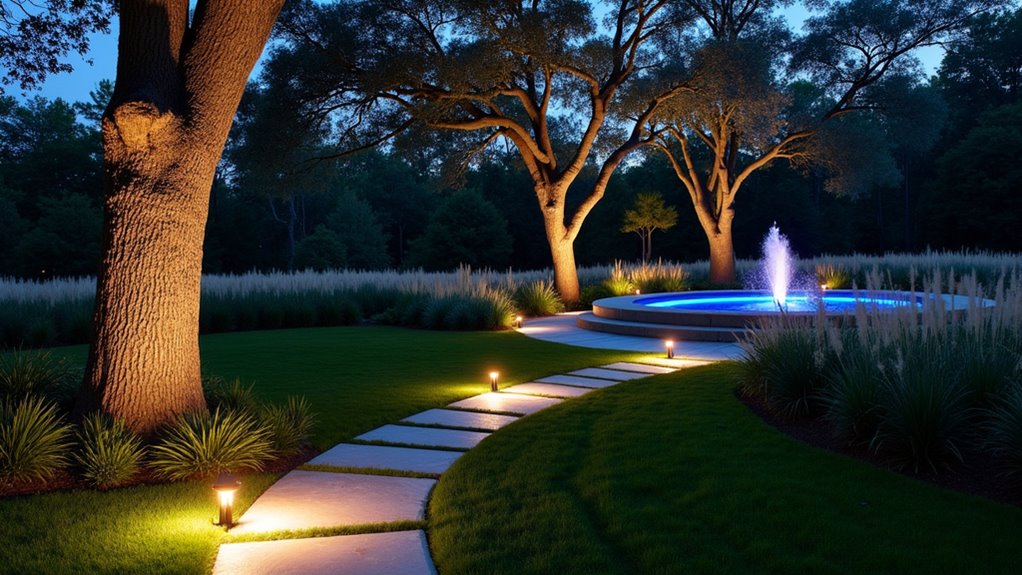
A garden’s enchantment doesn’t have to end when the sun sets. Strategic landscape lighting can transform your home’s exterior into an alluring nighttime retreat while augmenting security and functionality. By thoughtfully positioning light fixtures, you’ll create an inviting atmosphere that makes your dream home shine after dark.
- Install low-voltage path lights to illuminate walkways leading to your front door, ensuring safe passage while creating visual interest around container plants
- Implement moonlighting techniques by placing fixtures in trees, casting gentle shadows that mimic natural moonlight
- Use solar-powered accent lights to highlight architectural features and create depth in your landscape design
- Position spotlights strategically to showcase your home’s best features, creating dramatic effects that heighten curb appeal
These lighting solutions will extend your outdoor enjoyment while transforming your property into an evening showpiece.
Water-Smart Landscaping Techniques
Beyond enhancing your property’s nighttime appeal, creating a sustainable outdoor space demands thoughtful water management. We’ve compiled essential Landscaping Tips that’ll help you design a yard that’s both beautiful and water-efficient. Choose options like drought-resistant Agave, Lantana, and Yucca that require less water while still amplifying your home’s value.
Install smart irrigation systems with drip lines to deliver precise amounts of water directly to your plants’ roots. Group vegetation with similar hydration needs together, and replace traditional lawns with native ground covers or permeable hardscaping. Don’t forget to add 2-4 inches of organic mulch around your water features and planting beds – this simple step helps retain moisture and prevents weed growth, making your setting both sustainable and low-maintenance.
Maintaining Year-Round Landscape Beauty
While seasonal changes can challenge even experienced gardeners, creating year-round landscape beauty requires strategic plant selection and consistent maintenance. To amplify your home’s curb appeal throughout every season, you’ll need to combine evergreen plants with seasonal bloomers and maintain a rigorous care schedule. Fresh mulch applications twice yearly will bring new life to your beds while keeping your landscape looking polished and pristine.
Strategic plant selection and consistent care are the cornerstones of maintaining stunning landscape design throughout all four seasons.
- Mix evergreen foundational plants with perennials and annuals for continuous visual interest
- Follow a thorough maintenance schedule including mowing, pruning, and debris removal
- Improve curb appeal with proper tree and shrub shaping during prime growing periods
- Refresh mulch beds biannually and maintain strict weed control to guarantee a manicured appearance
These strategic approaches guarantee your landscape remains attractive and well-maintained through every season, maximizing your property’s aesthetic value year-round.
Budget-Friendly Enhancement Tips
Creating stunning scenery transformations doesn’t require breaking the bank. To enhance curb appeal, start with regular lawn maintenance using Scotts® Green Max™ Lawn Food every 6-8 weeks, which will make sure your grass stays lush and vibrant. For big impact on a budget, refresh your garden beds with Scotts® Nature Scapes® Mulch, which helps improve drainage while adding polished color to your landscaping.
You’ll see immediate results when you tackle the basics: mow consistently, trim overgrown bushes, and clear debris from your yard. Make your home’s curb appeal shine by cleaning windows with a simple vinegar-detergent solution, and restore hard surfaces using Scotts® Outdoor Cleaner. These affordable steps create professional-looking results without expensive landscaping services, proving that strategic maintenance can transform your outdoor space effectively.
Professional Design Considerations
Professional panoramic design consistently begins with an exhaustive evaluation of your property’s unique characteristics. When you’re working with a professional landscape expert, they’ll analyze vital elements like sun exposure, soil conditions, and existing landscape features to develop a comprehensive plan that complements your home’s architectural style.
A thoughtful landscape design starts with understanding your property’s DNA – from sunlight patterns to soil composition to existing natural features.
- Your designer will assess the property’s natural attributes, including drainage patterns, topography, and local climate to guarantee sustainable plant selection
- They’ll integrate hardscape elements that amplify both functionality and visual appeal while maintaining proportion
- You’ll receive guidance on plant combinations that thrive in your specific environment with minimal maintenance
- The design process will account for local regulations and building codes, confirming your landscape transformation meets all safety and compliance requirements
Frequently Asked Questions
What Adds the Most Curb Appeal?
You’ll create the most significant curb appeal by maintaining a lush green lawn as your foundation, then layering eye-catching flower beds and colorful container plants for visual interest. Add manicured hedges and well-maintained trees to frame your home’s architecture, while incorporating neatly edged pathways to guide the eye. These elements work together to create a polished, professional scene that instantly enhances your property’s aesthetic worth and general appeal.
How to Improve Curb Appeal With Landscaping?
You’ll optimize your home’s curb appeal through strategic shrub placement that frames your entryway and windows. Create depth with thoughtful lighting design to highlight architectural features after dark. Install vibrant flower beds with seasonal color palettes for year-round interest. Maintain manicured lawn edges and add decorative garden paths to guide visitors’ eyes to your front door. Keep plantings proportional to your home’s scale for a polished, professional appearance.
What Landscaping Adds Most Value?
You’ll amplify your property’s value by focusing on key landscaping elements. Install a balanced irrigation system to maintain lush greenery, and incorporate strategic garden edging to define spaces. Choose diverse plant selections with complementary color schemes for year-round visual interest. Invest in well-maintained pathways that create flow and functionality. Consider drought-resistant groundcover to reduce maintenance costs. These features together can elevate your home’s value by up to 20-28% in competitive markets.
What to Plant for Curb Appeal?
Create layers of visual interest by starting with colorful flower beds featuring petunias and marigolds as your foundation. Add drought-resistant shrubs like lantana and ornamental tree varieties such as crape myrtles for height variation. You’ll want to include fragrant garden plants and native plant selections like coneflowers to attract pollinators. Finish with low-maintenance ground covers to fill gaps and reduce weeding. This combination guarantees year-round appeal while keeping maintenance manageable.

